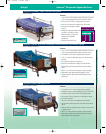
Invacare
®
Therapeutic Support Surfaces
Invacare
®
Therapeutic Support Surfaces
2
Patients immobilized and unable to move
can suffer serious destruction of the skin
and soft body tissue in as little as one
hour. This often results in the formation
of a pressure ulcer. A pressure ulcer is
defined as any lesion caused by
unrelieved pressure resulting in
underlying tissue damage.
Complications related to pressure ulcers
cause an estimated 60,000 deaths and
cost over $1.3 billion annually.
1
However,
most pressure ulcers are treatable and
even preventable. Therapeutic Support
Surfaces are a proven way to help
prevent and treat pressure ulcers.
Pressure ulcers can be caused by four factors, either individually or in
combination:
• Pressure: Results in compression of soft tissue between a bony
prominence and an external surface, such as a bed. When external
pressure exceeds capillary blood pressure, the blood supply from the
blood vessels to the muscle and skin tissue is impeded, resulting in
tissue breakdown.
• Moisture: Over-hydrates skin, resulting in maceration, which
lowers its resistance to mechanical stresses such as pressure or
friction.
• Shear: Occurs when adjacent surfaces slide across one another,
typically when a patient slides down in bed or chair. The skin
remains stationary against the bed linens while the underlying
tissue shifts. This causes capillaries to stretch and tear, resulting
in reduced blood flow.
• Friction: Caused when the skin is pulled across a coarse surface
such as bed linens, washcloths, or incontinence pads. When friction
is applied to the skin, the outer protective layer is rubbed away. The
soft moist layers of skin are exposed which allow bacteria to enter.
Understanding Pressure Ulcers
Pressure ulcers are typically located in areas such as heels, elbows, shoulders and
the sacral region and are graded or staged to classify the degree of tissue damage.
The images below identify pressure point areas in different body positions.
Causes of Pressure Ulcers
Immobility and Inactivity
One of the most important determinants of developing a pressure
ulcer is the ability to move or change positions. Lack of movement can
result in loss of blood flow to the muscles and skin.
Body Shape and Size
Those who are very thin or obese are at a higher risk of developing
pressure ulcers. Very thin people have little cushion between their
skin and bony prominences. Those who are overweight may have
difficulty moving around on their own.
Skin and hygiene
As well as advancing age, some medications or treatments can make
skin thinner and less able to take the wear and tear of everyday life.
Nutrition
Lack of a balanced diet and sufficient fluids can lead to frail skin.
Infection
An infection can cause an increase in body temperature and
perspiration, resulting in the skin being less supple.
Incontinence
Urine and fecal matter can cause irritation and skin breakdown.
It is important that the skin is cleaned and dried as soon as possible
to minimize maceration.
Circulation
Poor circulation can cause swelling, or edema, in certain areas,
making them less resistant to pressure.
Risk Factors for Pressure Ulcers
2
06-059 9/26/06 7:59 AM Page 2














